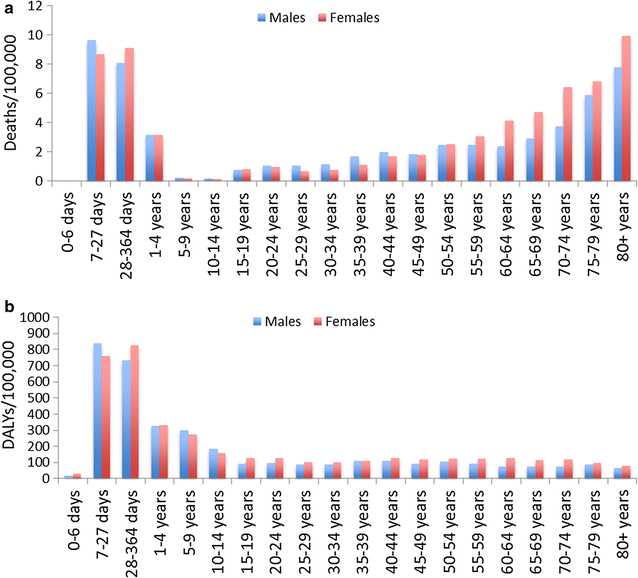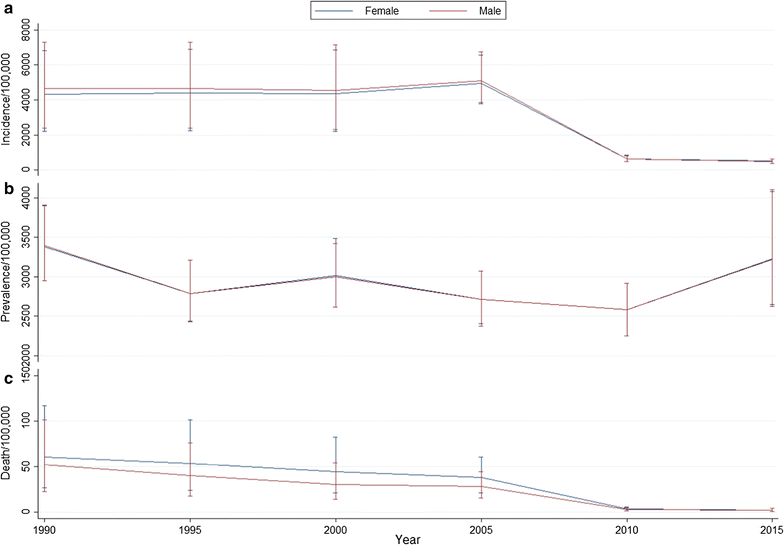Incidence, prevalence and mortality rates of malaria in Ethiopia from 1990 to 2015: analysis of the global burden of diseases 2015
- PMID: 28676108
- PMCID: PMC5496144
- DOI: 10.1186/s12936-017-1919-4
Incidence, prevalence and mortality rates of malaria in Ethiopia from 1990 to 2015: analysis of the global burden of diseases 2015
Abstract
Background: In Ethiopia there is no complete registration system to measure disease burden and risk factors accurately. In this study, the 2015 global burden of diseases, injuries and risk factors (GBD) data were used to analyse the incidence, prevalence and mortality rates of malaria in Ethiopia over the last 25 years.
Methods: GBD 2015 used verbal autopsy surveys, reports, and published scientific articles to estimate the burden of malaria in Ethiopia. Age and gender-specific causes of death for malaria were estimated using cause of death ensemble modelling.
Results: The number of new cases of malaria declined from 2.8 million [95% uncertainty interval (UI) 1.4-4.5 million] in 1990 to 621,345 (95% UI 462,230-797,442) in 2015. Malaria caused an estimated 30,323 deaths (95% UI 11,533.3-61,215.3) in 1990 and 1561 deaths (95% UI 752.8-2660.5) in 2015, a 94.8% reduction over the 25 years. Age-standardized mortality rate of malaria has declined by 96.5% between 1990 and 2015 with an annual rate of change of 13.4%. Age-standardized malaria incidence rate among all ages and gender declined by 88.7% between 1990 and 2015. The number of disability-adjusted life years lost (DALY) due to malaria decreased from 2.2 million (95% UI 0.76-4.7 million) in 1990 to 0.18 million (95% UI 0.12-0.26 million) in 2015, with a total reduction 91.7%. Similarly, age-standardized DALY rate declined by 94.8% during the same period.
Conclusions: Ethiopia has achieved a 50% reduction target of malaria of the millennium development goals. The country should strengthen its malaria control and treatment strategies to achieve the sustainable development goals.
Figures
References
-
- Federal Democratic Republic of Ethiopia, Ministry of Health. Health sector transformation plan. Addis Ababa. http://www.moh.gov.et/documents/26765/0/Health+Sector+Transformation+Pla.... Accessed 13 Jan 2016.
-
- UNDP. 2014 MDG report-Ethiopia. http://www.et.undp.org/content/ethiopia/en/home/library/mdg/EthiopiaMDG2.... Accessed 12 Jan 2016.
Publication types
MeSH terms
Grants and funding
LinkOut - more resources
Full Text Sources
Other Literature Sources
Medical




